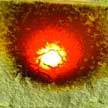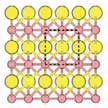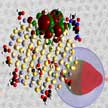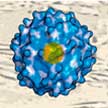Showing Spotlights 401 - 408 of 2780 in category All (newest first):
 Back in the spring of 2015, one of our Nanowerk Spotlights asked the question: 'Has nanomedicine lived up to its promise?' The answer then was that, judging by research activity and funding, the field of nanomedicine has been very fertile; however, by using the yardstick of clinical success and paradigm shifts in treatment, the results appear quite a bit more modest. So here we are, at the end of 2020, and the answer to that same question still is inconclusive. To address this problem, researchers now propose the creation of new nanomedicine design criteria.
Back in the spring of 2015, one of our Nanowerk Spotlights asked the question: 'Has nanomedicine lived up to its promise?' The answer then was that, judging by research activity and funding, the field of nanomedicine has been very fertile; however, by using the yardstick of clinical success and paradigm shifts in treatment, the results appear quite a bit more modest. So here we are, at the end of 2020, and the answer to that same question still is inconclusive. To address this problem, researchers now propose the creation of new nanomedicine design criteria.
Dec 14th, 2020
 Virtual reality (VR) and augmented reality (AR) are some of the hottest multidisciplinary technology trends right now, integrating computer, various sensor, graphic image, communication, measurement and control multimedia, artificial intelligence, and other technologies. Interactive electronic textiles will provide suitable platforms for VR/AR applications to provide a full range of sensory perceptions. Intrinsic conductive nanomaterials such as carbon nanotubes and metallic nanowires as well as nanoscale devices such as triboelectric nanogenerators are key to developing these electronic textiles.
Virtual reality (VR) and augmented reality (AR) are some of the hottest multidisciplinary technology trends right now, integrating computer, various sensor, graphic image, communication, measurement and control multimedia, artificial intelligence, and other technologies. Interactive electronic textiles will provide suitable platforms for VR/AR applications to provide a full range of sensory perceptions. Intrinsic conductive nanomaterials such as carbon nanotubes and metallic nanowires as well as nanoscale devices such as triboelectric nanogenerators are key to developing these electronic textiles.
Dec 7th, 2020
 Wearable thermal insulation materials for harsh environments always require a compromise during their design and manufacturing. On one hand they need to be mechanically tough to provide impact resistance. On the other hand they need to be heat resistant. Now, researchers have developed a wearable aramid/ceramic aerogel nanocomposite material with both excellent mechanical and thermal properties. The key to this fabrication method is the in situ crosslinking that takes place between the silica pre-ceramic aerogel precursor and the Kevlar fibers.
Wearable thermal insulation materials for harsh environments always require a compromise during their design and manufacturing. On one hand they need to be mechanically tough to provide impact resistance. On the other hand they need to be heat resistant. Now, researchers have developed a wearable aramid/ceramic aerogel nanocomposite material with both excellent mechanical and thermal properties. The key to this fabrication method is the in situ crosslinking that takes place between the silica pre-ceramic aerogel precursor and the Kevlar fibers.
Nov 30th, 2020
 One of the issues with microfluidic devices in life sciences is that most platforms rely on materials or chemicals that are outside the biological breadth as building blocks, scaffolds, or coatings for the devices. In a game-changing approach, researchers are developing a transformative way to fabricate microfluidic devices, where solid walls are replaced by transparent, morphing fluid walls using only biocompatible materials. This novel method can generate cell-friendly microfluidic devices on demand with features below 50 microns in size.
One of the issues with microfluidic devices in life sciences is that most platforms rely on materials or chemicals that are outside the biological breadth as building blocks, scaffolds, or coatings for the devices. In a game-changing approach, researchers are developing a transformative way to fabricate microfluidic devices, where solid walls are replaced by transparent, morphing fluid walls using only biocompatible materials. This novel method can generate cell-friendly microfluidic devices on demand with features below 50 microns in size.
Nov 19th, 2020
 Researchers have developed a theory of piezoelectrics with the goal to increase coherence times in quantum computers. In new work, they elucidate the mechanism of energy absorption taking place in quantum computers, and recommends optimal materials for these devices. The new theory predicts qubit coherence times that are over 100 times greater than the current state of the art. This shows that material improvements can go a long way towards improving the quality of quantum computing devices, bringing quantum advantage one step closer.
Researchers have developed a theory of piezoelectrics with the goal to increase coherence times in quantum computers. In new work, they elucidate the mechanism of energy absorption taking place in quantum computers, and recommends optimal materials for these devices. The new theory predicts qubit coherence times that are over 100 times greater than the current state of the art. This shows that material improvements can go a long way towards improving the quality of quantum computing devices, bringing quantum advantage one step closer.
Nov 18th, 2020
 The industrial production of ammonia mostly relies on the energy-intensive Haber-Bosch process, which causes significant environmental pollution. Researchers have now proposed that a class of 2D transition metal borides termed MBenes - the boron-analogues of MXenes - could be used as catalyst for ammonia production through electrochemical nitrogen reduction reaction (NRR). This work also provides a general design principle for further exploration of an even broader composition space of MBenes and other 2D NRR electrocatalysts.
The industrial production of ammonia mostly relies on the energy-intensive Haber-Bosch process, which causes significant environmental pollution. Researchers have now proposed that a class of 2D transition metal borides termed MBenes - the boron-analogues of MXenes - could be used as catalyst for ammonia production through electrochemical nitrogen reduction reaction (NRR). This work also provides a general design principle for further exploration of an even broader composition space of MBenes and other 2D NRR electrocatalysts.
Nov 17th, 2020
 Generally it is believed that core quantum dots (QDs) are good reducing agents and are used for that purpose in solar hydrogen generation and various organic transformations. However, core QDs are very unstable. Core/shell dots are more robust, but the shell minimizes redox activity. Researchers now demonstrate that this isn't perfectly true. In fact, they found that certain core/shell materials are a better reducing agent than the core alone. Most importantly, core/shell QDs are substantially more robust than the core alone.
Generally it is believed that core quantum dots (QDs) are good reducing agents and are used for that purpose in solar hydrogen generation and various organic transformations. However, core QDs are very unstable. Core/shell dots are more robust, but the shell minimizes redox activity. Researchers now demonstrate that this isn't perfectly true. In fact, they found that certain core/shell materials are a better reducing agent than the core alone. Most importantly, core/shell QDs are substantially more robust than the core alone.
Nov 13th, 2020
 With their ability to resist conventional chemotherapy drugs, cancer stem cells (CSC) are really difficult to kill, and they are considered to be key drivers in metastasis, the spread of cancer via the blood stream. If the frequency of CSCs could be diminished, tumors would be rendered less aggressive and more responsive to conventional therapy. This approach is known as differentiation therapy and has considerable therapeutic potential. Scientists now report an approach capable of efficient differentiation of CSCs into non-CSC phenotypes.
With their ability to resist conventional chemotherapy drugs, cancer stem cells (CSC) are really difficult to kill, and they are considered to be key drivers in metastasis, the spread of cancer via the blood stream. If the frequency of CSCs could be diminished, tumors would be rendered less aggressive and more responsive to conventional therapy. This approach is known as differentiation therapy and has considerable therapeutic potential. Scientists now report an approach capable of efficient differentiation of CSCs into non-CSC phenotypes.
Nov 10th, 2020
 Back in the spring of 2015, one of our Nanowerk Spotlights asked the question: 'Has nanomedicine lived up to its promise?' The answer then was that, judging by research activity and funding, the field of nanomedicine has been very fertile; however, by using the yardstick of clinical success and paradigm shifts in treatment, the results appear quite a bit more modest. So here we are, at the end of 2020, and the answer to that same question still is inconclusive. To address this problem, researchers now propose the creation of new nanomedicine design criteria.
Back in the spring of 2015, one of our Nanowerk Spotlights asked the question: 'Has nanomedicine lived up to its promise?' The answer then was that, judging by research activity and funding, the field of nanomedicine has been very fertile; however, by using the yardstick of clinical success and paradigm shifts in treatment, the results appear quite a bit more modest. So here we are, at the end of 2020, and the answer to that same question still is inconclusive. To address this problem, researchers now propose the creation of new nanomedicine design criteria.
 Subscribe to our Nanotechnology Spotlight feed
Subscribe to our Nanotechnology Spotlight feed





